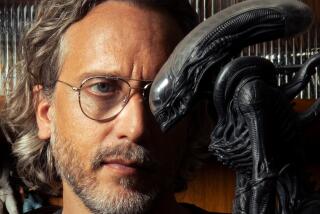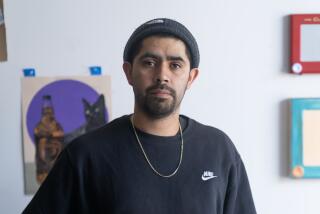Edwin Aguilar, who fled El Salvador’s civil war and later became a ‘Simpsons’ animator, dies
- Share via
Fans of “The Simpsons” might recognize his name from more than 20 years of credits on the cartoon institution; those who worked with him call him the “glue” that held together the Fox series’ family and a ray of “sunshine” within it. Animator, layout artist and assistant director Edwin Aguilar died Saturday after a stroke. He was 46.
“He was extremely friendly and had a good heart,” said David Silverman, a director on “The Simpsons.” “He had a calm understanding about him and a wicked sense of humor. When you’re picking teams, you want him on your side. He would definitely have your back.”
Aguilar was born in El Carao, in El Salvador‘s San Miguel province, in 1974. He told Efe, “When I was in El Salvador, I liked going to get the newspaper, and once I got it, I’d always look for the ‘Periquita’ and ‘Condorito’ comic strips so I could copy them.”
He and his brother fled the country, then embroiled in a 12-year civil war, when Edwin was 9, settling with the family in East Los Angeles.
Silverman said, “He told me his main reason for leaving was the civil war — at his age, that was when they were recruiting people. It was like a children’s army.”
Raymond Persi, a former director on “The Simpsons” who met Aguilar at art school, said: “He was smuggled here when he was young. He was stuck in one of those containers, you know, where everyone has to [urinate and defecate] in one jar, and having to take all his clothes and cross the river in the middle of the night.”
Silverman said, “Then he had to avoid the gang life that pervaded his upbringing in East L.A. He told me he woke up from a party once and he had a gunshot wound in his arm. I don’t know if it grazed him or what. He had a very relaxed attitude and sort of shrugged these things off.”
Persi said, “It was pretty terrifying, what he went through, and the fact that he was able to overcome all of those things and work really hard to spread joy and love — the funniest thing about him being a tough guy, he always said he felt safe around us because we weren’t going to get into trouble.”
“Simpsons” animation production supervisor Nikki Isordia said, “Whatever he went through in his childhood, whatever it took to get here, he had this positive, beautiful outlook on life. Nothing could be that bad when you talked with Edwin about it.”
Aguilar went on to attend the ArtCenter College of Design in Pasadena on an illustration scholarship and studied animation at the Bridges Visual Institute in Santa Monica.
He worked his way up through the animation ranks with companies such as Graz Entertainment (“G.I. Joe”) and Hanna-Barbera before joining the legendary Chuck Jones for a number of Warner Bros. shorts.
“When he was a kid in El Salvador, he used to draw Bugs Bunny and Daffy Duck,” said Silverman. “Then, years later, he works with Chuck Jones. Pretty incredible journey, when you think about it.”
Aguilar joined “The Simpsons” in 1998, eventually becoming an assistant director on the show.
“He was the glue for everyone,” said Isordia. “He made everyone feel at home. I can’t even remember being introduced to him, because I’ve just felt like I’ve known him my whole life. When I was feeling upset about something, I’d go to Edwin’s office, and he always knew the right thing to say: ‘You’ve gotta look at things this way.’ He was pure sunshine.
“I had some car trouble, I didn’t have AAA, I was late for work, I was in a nasty mood. I went to Edwin to tell him what was going on. About an hour later, I got an email from AAA about my new membership, which Edwin had set up and paid for without telling me.”
“Simpsons” supervising director Mike Anderson said, “As soon as you met him, he was your friend. We would do bootleg ‘Simpsons’ T-shirts together. He would do crew shirts. He did one of Mr. Burns as ‘Fruit Bat Man’ — the silhouette you’d see projected in the sky for Batman, but it’s Mr. Burns with his mask and horns.”
Colleagues expressed amazement at how Aguilar juggled the intense demands of working on “The Simpsons,” family life with his wife and three children and his determination to give back to his home country.
Isordia said, “He took trips to El Salvador; he took donations for clothes and food to bring there. He spent a lot of his life giving back to his country and people.”
Aguilar had been in declining health for several years due to diabetes; he had kidney ailments that led to heart issues. He had a stroke a few years ago and recovered, according to Anderson, then suffered another on April 8 and died in the ICU two days later. His final “Simpsons” episode, “Burger Kings,” aired the night after he died.
Isordia said, “The opening sequence, where Burns releases the hounds on Chief Wiggum, he really wanted to work on that scene: ‘I see it in my head; I want to make sure the dogs are done right.’”
Silverman said that when he thinks of Aguilar, “He would light up the room and light up your heart. He just had a great soul.”
Aguilar is survived by his wife, Marike, and three children, Jonathon, Maya and Bodhi. A GoFundMe has been established to benefit the family.
More to Read
The complete guide to home viewing
Get Screen Gab for everything about the TV shows and streaming movies everyone’s talking about.
You may occasionally receive promotional content from the Los Angeles Times.







